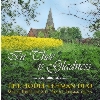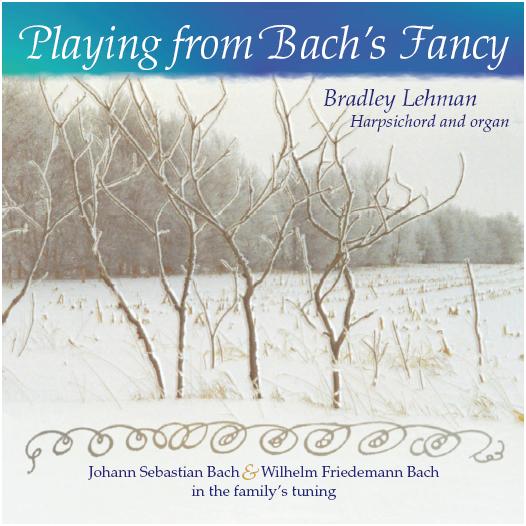
LaripS 1001: "In Thee is Gladness"
- The Hodel-Lehman Duo.
(Released in January 2005)
This CD includes music by Buxtehude, Brahms, Bach, Viviani, Baldassare, Pachelbel, Cellier, Bernstein, Starer, and Lehman. The recording was made at two churches in north Germany.
The performers are Martin Hodel, trumpet, and Bradley Lehman, organ.
[Samples on YouTube]
$15.00 plus $3.00 (within USA) for shipping, or $5.00 (outside USA): please send payment by
PayPal, and e-mailed instructions/inquiries, to bpl@umich.edu .


LaripS 1002: "A Joy Forever" / LaripS 1003: "Playing
from Bach's Fancy":
Organ and harpsichord recordings by Bradley Lehman.
(Released January 4th 2006 and available
through the Goshen College
Music Center, phone: (574)535-7361.)
[Samples on YouTube]
$15.00 for "Playing from Bach's Fancy" (harpsichord); $30.00 for "A Joy Forever" (organ; 3CD set). Add $3.00 (within USA) for shipping, or $5.00 (outside USA): please send payment by
PayPal, and e-mailed instructions/inquiries, to bpl@umich.edu .
These CDs present music played in what I believe to be Bach's tuning,
as described elsewhere on this web site.
They are a co-production with
Goshen College Central Recording,
for promotion of their
music department
and
facilities.
(I am an alumnus of this academic program, and was the harpsichord tuner on staff there for six years.)
The organ set includes music by Bach, Brahms, Pachelbel,
Sorge, Fischer, Erbach, Zachow, Böhm, Walther, and others.
It demonstrates the new two-manual
Taylor & Boody Opus 41 at Goshen College, with representative music in all keys.
It includes the complete Ariadne musica (1702/15) by JKF Fischer,
a set of 20 preludes and fugues plus five ricercars, a book that directly inspired Bach's composition of
the Well-Tempered Clavier. The goal here is to hear these pieces in a way that young
Bach may have played through them for his own study.
The harpsichord set includes Bach sinfonias, preludes and fugues, and
selections by other members of the Bach family: music that visits all the keys.
The harpsichord is a Franco/Flemish double by Knight Vernon
[photo 1,
photo 2]
modeled on 17th century Ruckers instruments.
Press release for LaripS 1002 and 1003
This is to announce two new CD sets released January 4th 2006,
recorded in March 2005. I am the performer and producer of
both of these sets.
They use the specific keyboard tuning that
I believe was Bach's own, which evidence I have explained at
http://www.larips.com
and in various publications during 2005 (Early Music,
The Diapason, Clavichord International,
BBC Radio 3 broadcast, et al).
http://www-personal.umich.edu/~bpl/larips/articles.html
The organ set "A Joy Forever: Opus 41 at Goshen College" demonstrates
the new two-manual pipe organ at Goshen College (Indiana), built by
Taylor & Boody Organbuilders (Virginia). The music is by Bach,
Brahms, Walther, Fischer, Erbach, Zachow, and some others. It includes
a complete recording of Fischer's
Ariadne musica with its twenty preludes and fugues, and
five ricercars: a book that inspired
Bach's composition of the Well-Tempered Clavier. The details of this
set are at
http://www-personal.umich.edu/~bpl/larips/cd1002.html
3 CDs, $30.00 USD plus shipping. Total time slightly over 3 hours.
The single disc "Playing From Bach's Fancy" has nearly an hour of
harpsichord music by JS Bach and WF Bach, and 20 minutes on the
organ. Preludes, fugues, sinfonias, polonaises, duetti, chorale
preludes, excerpts from the Musical Offering and Art of Fugue, and
several other tidbits. The harpsichord is a Franco/Flemish style
double by Knight Vernon, and owned by Goshen College. The album
details are at
http://www-personal.umich.edu/~bpl/larips/cd1003.html
1 CD, $15.00 USD plus shipping. Total time 77 minutes.
The Taylor & Boody organ Opus 41 used in these recordings:
http://www.taylorandboody.com/opuses/opus_41.htm
http://gcmusiccenter.org/the-basics/facilities/rieth-recital-hall/opus-41-pipe-organ/
http://www-personal.umich.edu/~bpl/larips/tb41.html
Goshen College's press release about the two recordings:
http://www.goshen.edu/news/pressarchive/01-13-06-organ-cd.html
Ordering information:
Goshen College music office, (574)535-7361